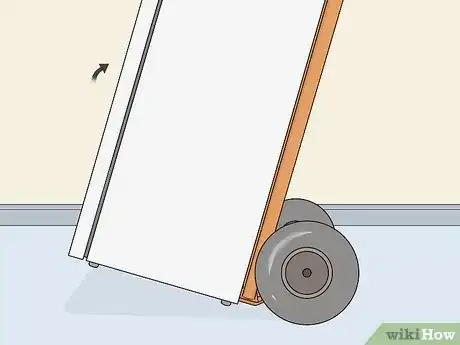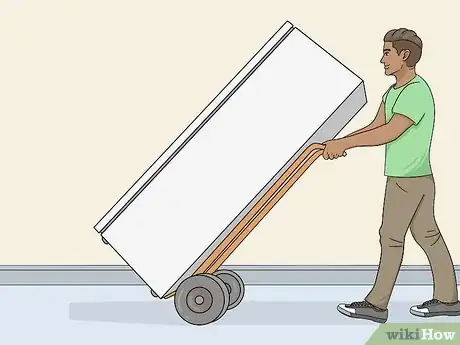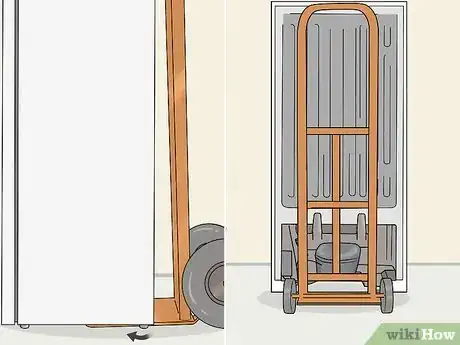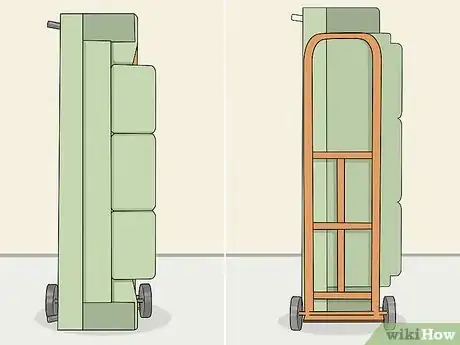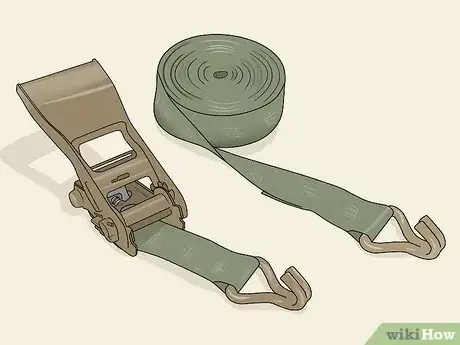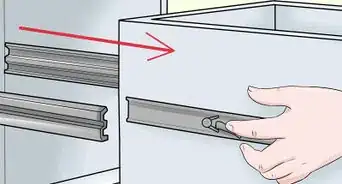This article was co-authored by wikiHow Staff. Our trained team of editors and researchers validate articles for accuracy and comprehensiveness. wikiHow's Content Management Team carefully monitors the work from our editorial staff to ensure that each article is backed by trusted research and meets our high quality standards.
There are 11 references cited in this article, which can be found at the bottom of the page.
This article has been viewed 18,674 times.
Learn more...
A dolly, also known as a hand truck, is a type of wheeled cart used to move large, heavy, or otherwise unwieldy objects. A dolly can spare you a lot of back-breaking labor during your next moving project, but it’s important to use the device correctly in order to keep yourself and your belongings safe. Start by sliding the dolly’s bottom plate under the object you’re loading and gently tilting the cart backwards until the item’s full weight is balanced over the wheels. Then, push the cart along slowly and carefully, using your free hand or a set of adjustable straps to keep the item secured.
Things You Should Know
- To balance an object while you're moving it, slide the plate of the dolly under the item, then tip it backward until the weight is distributed over the wheels.
- If you're moving boxes, stack them squarely on top of each other with the biggest, heaviest boxes on the bottom.
- If you're moving something bulky like an appliance or furniture, secure it to the dolly with straps or bungee cables so it doesn't shift.
- When you're moving on flat ground, push the dolly from behind, but pull it from the front if you have to go up a hill.
Steps
Working with a Dolly
-
1Make sure you have adequate clearance when loading the item you’re moving. If possible, pull the item away from any nearby walls, furniture, or other potential obstacles. You want to give yourself plenty of room to get your dolly into position and wheel your item away once you’ve got it loaded.[1]
- Ideally, there should be at least 2–3 feet (0.61–0.91 m) of space on all sides of your object.
-
2Slide the dolly’s bottom plate all the way under the base of your item. Align the thin metal plate on the lower part of the dolly with the midpoint of the object. Then, stand it straight up and inch it forward until the edge of the item is resting flush against the vertical support bars on the backside of the cart.[2]
- Make sure the bottom plate is perfectly centered under your item. If it’s not, there’s a chance that the item may tip or slide once you get it lifted.
Tip: When moving especially large or heavy objects, you may need to have another person assist you in raising one side of the item up enough to slip the bottom plate underneath.[3]
Advertisement -
3Tilt the dolly back onto its wheels while using one hand to steady the load. Brace the cart by placing your foot against the horizontal rail just behind the bottom plate and pull back gently on one of the vertical bars. As you do, keep one hand pressed against the front edge of your item (the side opposite the dolly) to help ease it back and prevent it from tipping in the wrong direction. You’re now ready to begin moving.[4]
- It’s a good idea to have someone else stationed on the front side of the item just in case it rocks or shifts unexpectedly.[5]
- Some dollies have molded handles on the rear edge that can make it easier to find and maintain a secure grip.
-
4Balance your cargo carefully as you maneuver the dolly. Keep the cart at such an angle that the weight of the item remains evenly distributed over the wheels. Push the dolly along with a slow, unhurried pace, feeling for changes in the distribution of the weight and making adjustments as needed.[6]
- If you hold the dolly too upright, the item may pitch right off the front end. If you lean it back too much, more of the item’s weight will be transferred to you, which can make moving difficult and dangerous.
- Avoid making sharp turns while your cargo is in motion, or stopping too abruptly when you reach your destination or pause to rest.[7]
Loading Various Items
-
1Choose a dolly based on the type of item you’re moving. Dollies come in three basic varieties: utility dollies, or hand trucks, appliance dollies, and furniture dollies. A utility dolly should be all you need to move a few boxes or light pieces of furniture, while a heavy-duty appliance dolly will make light work of your cooking and cleaning staples. For large, unwieldy pieces of decor, a flat furniture dolly will be your best best.[8]
- Appliances dollies are just like standard utility dollies, only larger and able to support far more weight. They also usually come with their own straps, which can lend added security to difficult moving tasks.
- Furniture dollies have four wheels instead of two, and are designed to hold hundreds or even thousands of pounds. These features make loading and transporting even the most extravagant pieces a breeze.[9]
-
2Stack boxes squarely to keep them from shifting. When moving multiple boxes at once, load each one so that the majority of its weight is in line with the center of the cart. If the boxes are all the same size, line their edges up with one another. If not, try to place them in the most stable configuration possible.[10]
- Always load your boxes from heaviest to lightest, with the biggest, bulkiest boxes at the bottom of the stack.
- You can pile on boxes all the way up to the end of the vertical supports for maximum efficiency. Just be sure the top box isn’t so high that it blocks your view or causes the load to become top-heavy.[11]
-
3Approach heavy appliances from behind. Household fixtures like refrigerators, dishwashers, and ovens tend to be heaviest and most solidly-built at the back. The best way to tackle them is therefore to coax them away from their enough to turn them around and bring the dolly in behind them rather than putting them on “face first.” This lowers your chances of leaving unsightly scratches on visible surfaces.[12]
- Wrap trailing electrical cords around the body of the appliance, or tape them to an out-of-the-way part of the housing to make sure that they stay put.
- Some moving experts recommend loading certain types of appliances from the side in order to avoid accidentally damaging their mechanical or electrical components.[13]
-
4Arrange large, unwieldy pieces of furniture vertically. Stand sofas, horizontal dressers, benches, and similar pieces up on one side to put as much surface area in contact with the dolly as possible. Turn vertical dressers, armoires, decorative cabinets, and other items with legs upside down to create a more stable base.[14]
- The only real difference between loading a utility dolly and loading a furniture dolly is that it will be necessary to lift or tip the piece over onto the dolly rather than leveraging it up with the bottom plate.
- Emptying out furniture items that double as storage solutions prior to moving them will reduce their weight drastically. It’s also wise to wrap pieces containing drawers with plastic or rubber bands to prevent them from sliding out.[15]
Tip: Cover the bottom and sides of the dolly with furniture pads or sheets of cardboard to provide a layer of protection against scratches.
Moving your Cargo Safely
-
1Make sure your intended path is clear before you get started. Prior to loading your first item or items, scan the route you plan on taking for potential obstructions. Scoot furniture and other large objects back to the walls, and take a moment to pick up smaller pieces of clutter that might slow your progress. You want to avoid having to compete for floor space as much as possible.[16]
- Measure each doorway and opening you'll be passing through with the dolly ahead of time. Otherwise, you may be setting yourself up for frustration later on.[17]
- Plotting and clearing your path will also give you a chance to work out an alternate route if you happen to discover that a particular area is impassable.
-
2Use straps to secure especially heavy or precarious loads. After positioning the dolly under the item you want to move, stop and wrap one or more straps around both it and the cart’s vertical supports. Wind the straps multiple times, then cinch them down tight. You’ll then be able to focus on maneuvering the dolly without worrying about losing control over your cargo.[18]
- Ratchet straps are most commonly used for moving jobs. However, you could also use hook or tie-down style straps if they’re what you have on hand.
- Assuming you don’t have any proper straps available, a set of bungee cables or few lengths of durable nylon rope will help you get the job done, as well.[19]
-
3Push the dolly on flat ground, but pull it up hills. Under normal circumstances, putting your weight behind the cart will allow you to build up a little momentum, resulting in far less work for you. When moving up an incline, however, it’s safer to turn around and pull the dolly behind you. Doing so will also keep you out of the cart’s path in the event of an accident.[20]
- If you’re pushing the dolly straight ahead, lean into it. If you’re pulling it uphill, or going down a slight decline, lean away from it.
-
4Guide the dolly smoothly over stairs. On your way up a flight of stairs, get one or two steps ahead of the dolly and use your superior leverage to hoist it up each step, similar to the way you would pull uphill. When going down, ease both wheels over the edge of each step and down onto the next simultaneously. Take it slowly, concentrating on a single step at a time until you reach the level you need to be on.[21]
- Always have a second person standing by to lend you a hand on stairways. It’s not safe to try to negotiate them on your own, no matter how short they might be.[22]
Warning: Be careful not to lean the dolly back too much when going down stairs. If the vertical supports get low enough, the wheels could miss the edge of the next step, sending the cart, and your cargo, sliding down the rest of the way.
References
- ↑ https://movinginsider.com/2014/02/11/how-to-use-an-appliance-dolly/
- ↑ https://www.goshare.co/how-to-use-an-appliance-dolly-tutorial-with-pictures/
- ↑ https://www.youtube.com/watch?v=eGr1lcB-vFU&feature=youtu.be&t=37
- ↑ https://blog.hireahelper.com/how-to-use-a-dolly-like-the-pros/
- ↑ https://www.goshare.co/how-to-use-an-appliance-dolly-tutorial-with-pictures/
- ↑ https://www.youtube.com/watch?v=_7Tqrl3XnPc&feature=youtu.be&t=67
- ↑ https://www.mga.edu/environmental-health-safety/docs/safety-manual/equipment/info/Hand_Trucks_and_Dollies.pdf
- ↑ https://moving.tips/moving-day-tips/moving-dolly/
- ↑ https://www.bestreviews.guide/furniture-dolly
- ↑ https://moving.tips/moving-day-tips/moving-dolly/
- ↑ https://blog.hireahelper.com/how-to-use-a-dolly-like-the-pros/
- ↑ https://blog.hireahelper.com/how-to-use-a-dolly-like-the-pros/
- ↑ https://www.goshare.co/how-to-use-an-appliance-dolly-tutorial-with-pictures/
- ↑ https://moving.tips/moving-day-tips/moving-dolly/
- ↑ https://blog.hireahelper.com/how-to-use-a-dolly-like-the-pros/
- ↑ https://blog.hireahelper.com/how-to-use-a-dolly-like-the-pros/
- ↑ https://movinginsider.com/2014/02/11/how-to-use-an-appliance-dolly/
- ↑ https://www.youtube.com/watch?v=eGr1lcB-vFU&feature=youtu.be&t=95
- ↑ https://www.lifestorage.com/blog/moving/how-to-move-a-refrigerator/
- ↑ https://www.mga.edu/environmental-health-safety/docs/safety-manual/equipment/info/Hand_Trucks_and_Dollies.pdf
- ↑ https://careertrend.com/how-4598291-use-hand-trucks-stairways.html
- ↑ https://blog.hireahelper.com/how-to-use-a-dolly-like-the-pros/


